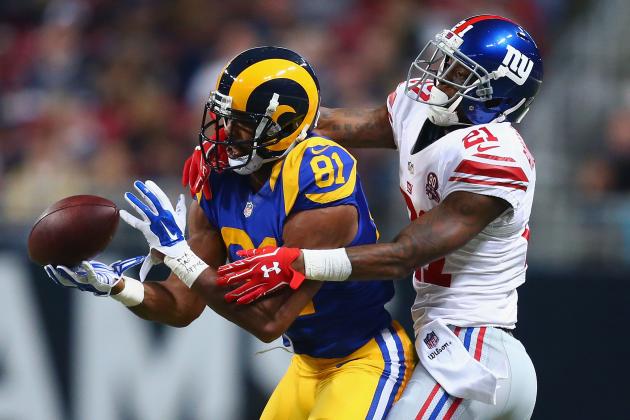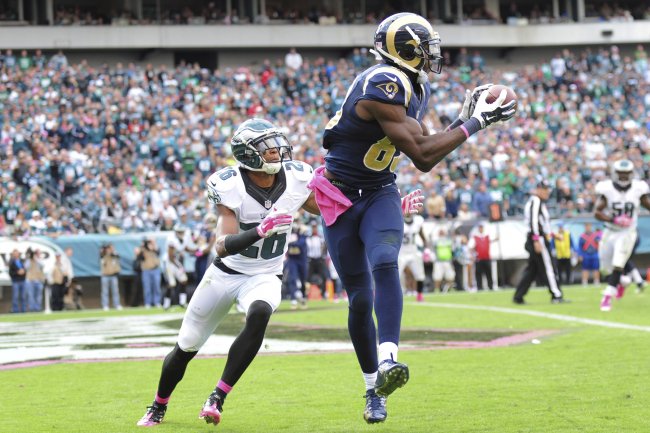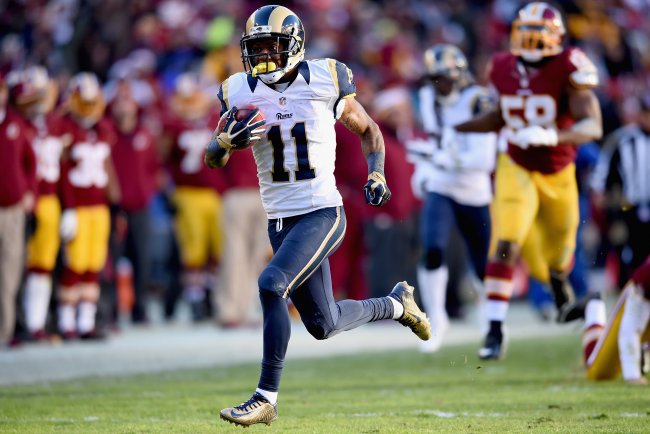http://bleacherreport.com/articles/...wn-and-depth-chart-analylsis-at-wide-receiver
Rams: Full Position Breakdown and Depth Chart Analylsis at Wide Receiver
By Steven Gerwel, Featured Columnist Jun 2, 2015

The St. Louis Rams are built as a run-first team, but that doesn't mean the aerial game has no purpose. The wide receivers have enough talent to supplement the run game and play a big role on offense.
The Rams lack a proven No. 1 wide receiver, which might lead some to believe that St. Louis is incapable of getting it done through the air. Then again, it's not impossible to create a healthy passing game with a platoon of No. 2 and No. 3 receivers, which is basically what St. Louis has.
Last season, the San Diego Chargers finished with the No. 10 overall passing offense (256.1 yards per game), though not a single San Diego pass-catcher hit 900 yards. The New Orleans Saints receivers were all limited to less than 1,000 yards, yet the Saints finished with the No. 3 passing offense in the NFL (297.8).
The Rams are not striving to become a top-notch passing team, but that doesn't mean they can't be productive through the air. St. Louis has talent at receiver; it's just a matter of how the team wishes to utilize that talent.
This article will break down the wide receiver position. We'll discuss what each player has to offer and predict the current depth chart.

Evan Habeeb/Getty Images
Final 53-Man Roster Depth Chart
St. Louis went with six receivers in 2012 and 2013, but the team kept just five last season. If five is once again the magic number, it should be an interesting fight between Bud Sasser and Chris Givens. Other than that, there's not a whole lot to debate.
Brian Quick really stepped up his game in 2014. He had 21 catches, 322 yards and three touchdowns in the first four games. He cooled off the following two weeks (three catches for 43 yards), but those were tough defensive games against the San Francisco 49ers and Seattle Seahawks.
In the seventh game of the season—against the Kansas City Chiefs—Quick suffered a devastating shoulder injury. According to Nick Wagoner of ESPN.com, Quick separated his shoulder and tore therotator cuff. There's no timetable for his return, and there hasn't been an update in over two months.
Things are clearly starting to click for Quick on the field, but there's some concern that the recovery process will hold him back. If Quick isn't 100 percent, the team will depend on Kenny Britt as the top guy.
Britt had at least one catch in 15 games last season, but he exceeded five catches in a game just once. He produced on a weekly basis, but that production was rather modest. It was a comeback season for Britt, who recorded 748 yards (his highest total since 2010). Perhaps he'll have more of a breakout campaign in his second year with the team.
Stedman Bailey is the dark-horse candidate for the No. 1 job. An early-season suspension limited his 2014 action and put him in the doghouse, but he came on strong toward the end of the year. He finished with just 435 yards, but 349 of those yards came in the final six games.
Bailey is a promising route-runner and has the speed to get downfield. With two years of experience under his belt, he could be a breakout candidate in Year 3.
The major question mark, of course, is Tavon Austin. The former No. 8 overall pick from 2013 is an excellent returner on special teams, but his offensive production suffered last year. He was held under 500 yards (466) from scrimmage (hardly ideal production for a top-10 pick).
Austin has endured inconsistency at the quarterback position and the questionable play-calling of former offensive coordinator BrianSchottenheimer, but so what? Six other Rams receivers dealt with the same disadvantages and still put up more receiving yards than Austin.
Even Bailey—who had just four receptions by midseason—managed to nearly double Austin's 242 receiving yards last year. As a result, it's now or never for Austin. He has to make something happen in 2015.
As for Givens and Sasser, it should be a tight race.
Sasser, the rookie sixth-round pick out of Missouri, is pretty raw. He has very promising size at 6'2" and 210 pounds, but his one season of collegiate experience will hold him back.
Givens is entering his fourth year, and the veteran is a known deep-ball threat. Unfortunately, he doesn't offer much in the short or intermediate range, so he has been phased out of the offense.
The top six St. Louis receivers won't catch the eyes of fantasy owners, but it's a talented group with lots of potential. Expect this group to get it done despite the offense's desire to run the football.

Patrick Smith/Getty Images
Second-Tier Wide Receiver Depth Chart
Damian Williams was a third-round pick by the Tennessee Titans in 2010 (Jeff Fisher's final draft class with that franchise). His best campaign came in 2011, when he caught 45 passes for nearly 600 yards (592) and five touchdowns.
Williams had just one reception with the Miami Dolphins in 2014, but his five years of NFL experience give him an edge. If any second-tier receiver has a shot at beating out Sasser or Givens, it's Williams.
Devon Wylie and Emory Blake are the two most experienced guys behind Williams. Wylie had six catches with Kansas City in 2012 but has seen little action since. Blake has been on the St. Louis practice squad the last two seasons.
Isiah Ferguson, Tyler Slavin, Bradley Marquez and Daniel Rodriguez are all undrafted rookie additions. They're facing an uphill battle when it comes to making the team and even the practice squad.
Ferguson, a small-school guy out of Arkansas-Pine Bluff, is interesting because of his size. At 6'4" and 218 pounds, he's the tallest wide receiver on the roster and a possible red-zone threat.
Tyler Slavin was originally a Division I talent and played for the Arizona Wildcats in 2012 (224 yards and one touchdown). He finished his career at New Mexico Highlands University and produced 1,418 yards and 17 touchdowns in 2014.
Clemson's Daniel Rodriguez is a long shot, but he has a very interesting story nonetheless. According to his Clemson bio, he served in the Army from 2006 to 2010 and spent time in both Iraq and Afghanistan. While in Afghanistan, he was present at the Battle ofKamdesh on October 3, 2009. During the bloody conflict, 38 U.S. troops battled against approximately 300 Taliban fighters. Eight Americans lost their lives, and Rodriguez was awarded the Purple Heart and Bronze Star.
For more on Rodriguez's story and military service, read this piece by Bleacher Report's Greg Wallace.
As for the "second-tier" receivers at Rams Park, it'll be difficult for any of them to immediately crack the 53-man roster. However, they can always find a spot on the practice squad, where they'll have a chance to properly develop their skills.
Steven Gerwel is the longest-tenured Rams featured columnist at Bleacher Report and served as the Rams' game-day correspondent in 2014. You can find more of Gerwel's work by visiting his writer profile or following him on Twitter.
Rams: Full Position Breakdown and Depth Chart Analylsis at Wide Receiver
By Steven Gerwel, Featured Columnist Jun 2, 2015

The St. Louis Rams are built as a run-first team, but that doesn't mean the aerial game has no purpose. The wide receivers have enough talent to supplement the run game and play a big role on offense.
The Rams lack a proven No. 1 wide receiver, which might lead some to believe that St. Louis is incapable of getting it done through the air. Then again, it's not impossible to create a healthy passing game with a platoon of No. 2 and No. 3 receivers, which is basically what St. Louis has.
Last season, the San Diego Chargers finished with the No. 10 overall passing offense (256.1 yards per game), though not a single San Diego pass-catcher hit 900 yards. The New Orleans Saints receivers were all limited to less than 1,000 yards, yet the Saints finished with the No. 3 passing offense in the NFL (297.8).
The Rams are not striving to become a top-notch passing team, but that doesn't mean they can't be productive through the air. St. Louis has talent at receiver; it's just a matter of how the team wishes to utilize that talent.
This article will break down the wide receiver position. We'll discuss what each player has to offer and predict the current depth chart.

Evan Habeeb/Getty Images
Final 53-Man Roster Depth Chart
- Brian Quick
- Kenny Britt
- Stedman Bailey
- Tavon Austin
- Chris Givens
- Bud Sasser
St. Louis went with six receivers in 2012 and 2013, but the team kept just five last season. If five is once again the magic number, it should be an interesting fight between Bud Sasser and Chris Givens. Other than that, there's not a whole lot to debate.
Brian Quick really stepped up his game in 2014. He had 21 catches, 322 yards and three touchdowns in the first four games. He cooled off the following two weeks (three catches for 43 yards), but those were tough defensive games against the San Francisco 49ers and Seattle Seahawks.
In the seventh game of the season—against the Kansas City Chiefs—Quick suffered a devastating shoulder injury. According to Nick Wagoner of ESPN.com, Quick separated his shoulder and tore therotator cuff. There's no timetable for his return, and there hasn't been an update in over two months.
Things are clearly starting to click for Quick on the field, but there's some concern that the recovery process will hold him back. If Quick isn't 100 percent, the team will depend on Kenny Britt as the top guy.
Britt had at least one catch in 15 games last season, but he exceeded five catches in a game just once. He produced on a weekly basis, but that production was rather modest. It was a comeback season for Britt, who recorded 748 yards (his highest total since 2010). Perhaps he'll have more of a breakout campaign in his second year with the team.
Stedman Bailey is the dark-horse candidate for the No. 1 job. An early-season suspension limited his 2014 action and put him in the doghouse, but he came on strong toward the end of the year. He finished with just 435 yards, but 349 of those yards came in the final six games.
Bailey is a promising route-runner and has the speed to get downfield. With two years of experience under his belt, he could be a breakout candidate in Year 3.
The major question mark, of course, is Tavon Austin. The former No. 8 overall pick from 2013 is an excellent returner on special teams, but his offensive production suffered last year. He was held under 500 yards (466) from scrimmage (hardly ideal production for a top-10 pick).
Austin has endured inconsistency at the quarterback position and the questionable play-calling of former offensive coordinator BrianSchottenheimer, but so what? Six other Rams receivers dealt with the same disadvantages and still put up more receiving yards than Austin.
Even Bailey—who had just four receptions by midseason—managed to nearly double Austin's 242 receiving yards last year. As a result, it's now or never for Austin. He has to make something happen in 2015.
As for Givens and Sasser, it should be a tight race.
Sasser, the rookie sixth-round pick out of Missouri, is pretty raw. He has very promising size at 6'2" and 210 pounds, but his one season of collegiate experience will hold him back.
Givens is entering his fourth year, and the veteran is a known deep-ball threat. Unfortunately, he doesn't offer much in the short or intermediate range, so he has been phased out of the offense.
The top six St. Louis receivers won't catch the eyes of fantasy owners, but it's a talented group with lots of potential. Expect this group to get it done despite the offense's desire to run the football.

Patrick Smith/Getty Images
Second-Tier Wide Receiver Depth Chart
- Damian Williams
- Emory Blake
- Devon Wylie
- Isiah Ferguson
- Tyler Slavin
- Bradley Marquez
- Daniel Rodriguez
Damian Williams was a third-round pick by the Tennessee Titans in 2010 (Jeff Fisher's final draft class with that franchise). His best campaign came in 2011, when he caught 45 passes for nearly 600 yards (592) and five touchdowns.
Williams had just one reception with the Miami Dolphins in 2014, but his five years of NFL experience give him an edge. If any second-tier receiver has a shot at beating out Sasser or Givens, it's Williams.
Devon Wylie and Emory Blake are the two most experienced guys behind Williams. Wylie had six catches with Kansas City in 2012 but has seen little action since. Blake has been on the St. Louis practice squad the last two seasons.
Isiah Ferguson, Tyler Slavin, Bradley Marquez and Daniel Rodriguez are all undrafted rookie additions. They're facing an uphill battle when it comes to making the team and even the practice squad.
Ferguson, a small-school guy out of Arkansas-Pine Bluff, is interesting because of his size. At 6'4" and 218 pounds, he's the tallest wide receiver on the roster and a possible red-zone threat.
Tyler Slavin was originally a Division I talent and played for the Arizona Wildcats in 2012 (224 yards and one touchdown). He finished his career at New Mexico Highlands University and produced 1,418 yards and 17 touchdowns in 2014.
Clemson's Daniel Rodriguez is a long shot, but he has a very interesting story nonetheless. According to his Clemson bio, he served in the Army from 2006 to 2010 and spent time in both Iraq and Afghanistan. While in Afghanistan, he was present at the Battle ofKamdesh on October 3, 2009. During the bloody conflict, 38 U.S. troops battled against approximately 300 Taliban fighters. Eight Americans lost their lives, and Rodriguez was awarded the Purple Heart and Bronze Star.
For more on Rodriguez's story and military service, read this piece by Bleacher Report's Greg Wallace.
As for the "second-tier" receivers at Rams Park, it'll be difficult for any of them to immediately crack the 53-man roster. However, they can always find a spot on the practice squad, where they'll have a chance to properly develop their skills.
Steven Gerwel is the longest-tenured Rams featured columnist at Bleacher Report and served as the Rams' game-day correspondent in 2014. You can find more of Gerwel's work by visiting his writer profile or following him on Twitter.
